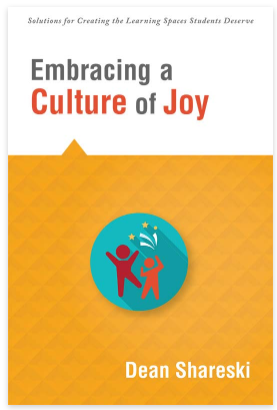
Educators all over the world are sharing just one word that means something to them for 2017 on social media. I thought of several words that meant a lot to me: gratitude, creativity, love, imagination … but they just didn’t encompass everything I want for this year. I started thinking of why I do what I do for education and for kids.
Recently I found a presentation I did over six years ago (November, 2010) “Joy in Learning” with Roxanne Clement (@rclement) for the Global in Education Conference. It brought back a warmth about this concept that I want to share again. I always had this feeling that if we made joy a priority in learning, everything else that was positive would follow. I even wrote a post in 2010 called “Why Joy Matters.” So my one word for 2017 is “Joy.” Today I joined the 30 Day Challenge for Blogging from A.J. Juliani and decided to do my first blog post on “Joy.”
Today, I also came across Akilah Ellison’s (@OrganicLeaderVB) blog post “Joy is Revolutionary” where she asked the question “What do you pile on your plate that brings you joy?” I love this question. She also brought up how it is a delicate balance to keep your balance that includes joy because we tend to put so much on our plates. We also tend to put off “joy” and “fun” because we are all working way too hard. She brought up colors, music, intentional words, and best of all… self-care. Please take a moment to read her post.
Joy is all about what touches your heart. Like Steve Jobs said in a commencement speech in 2005, “Do what makes your heart sing!” Wow!
Consider a Joy Map which is a great way to create more joy and healing in your life. The joy map is designed to help you get in touch with your heart and soul, what makes you tick, and what you love.

http://www.thedynamicturnaround.com/livingeachday.htm
When you identify what brings you joy, you have a clearer picture of what motivates you so you can spend your time doing what is most important for you. If you are doing what brings you joy, life is definitely more fun.
I know what “JOY” is for me. It’s that feeling of doing something I’m passionate about. It’s when I cannot wait to jump out of bed to do whatever it is I’m excited about. Wouldn’t that be great if our kids felt like that about learning or when they are in school? What if kids created their own “Joy Map” at the beginning of school and referred or updated it during the year? How can we include more joy in school?
 Dean Shareski (@shareski) wrote “Embrace a Culture of Joy” to help educators bring joy to their classrooms every day. He shares the rationale about why we need to have meaningful conversations about where joy gets left out in schools, as well as to live fulfilling lives—by bringing joy to classrooms each day. He discusses how you can create a sense of community-based on relationships between teachers and students. He also has readers discover the importance of wonder and inquiry in making students more engaged in their learning. I highly recommend his book.
Dean Shareski (@shareski) wrote “Embrace a Culture of Joy” to help educators bring joy to their classrooms every day. He shares the rationale about why we need to have meaningful conversations about where joy gets left out in schools, as well as to live fulfilling lives—by bringing joy to classrooms each day. He discusses how you can create a sense of community-based on relationships between teachers and students. He also has readers discover the importance of wonder and inquiry in making students more engaged in their learning. I highly recommend his book.
I’ll be sharing more about joy in more posts and on social media. We need joy in our lives now more than ever; especially our kids. The focus on academics has not prepared our kids for life and their future. Let’s rethink teaching and learning so all of us have more joy in our lives. Look at the joy Audri shares in his video about his Rube Goldberg Monster Trap when he was 7 years old (2012).
He only had four failures. We need to allow time for taking risks, experimenting, tinkering, giggling, and even being silly. Just imagine if every kid in your class was as excited about learning as Audri showed in this video.
****
This post is the beginning of my 30 Day Challenge from A.J. Juliani to post at least 1-3 blog posts a week for 30 days. I love that my first post for 2017 is on joy. I hope you enjoy it and welcome your comments.
*****
Interested in checking out the Rethinking Learning podcasts and reflections, click on the podcast tab at the top, the logo below, or go to https://barbarabray.net/podcasts/
For more information about Barbara’s book, Define Your WHY, go to this page or click on the image of the book for resources, questions, and links.




